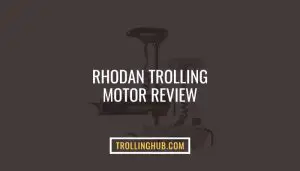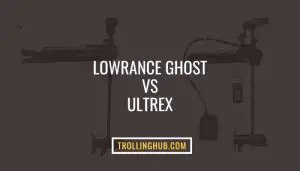As a beginner, there are a lot of different terms and techniques to get acquainted with in fishing. The debate of trolling vs trawling is one topic you’ve probably come across. These words sound very similar but have different purposes and methods.
And while trawling is mainly used for commercial purposes, you might be curious about trying it out for recreational means, to catch more fish. Let’s go over what each of these terms mean and you can decide for yourself what technique you should stick to.
What is Trolling Fishing
Trolling refers to the act of dragging bait or fishing lure across the water to make it seem like the bait is alive and moving. The movement can attract more fish as they think it is live prey. It is usually done by securing one or more fishing rods on a trolling fishing boat and letting it move across the water at various speeds.
Different species of fish tend to enjoy different trolling patterns, and by mastering these patterns you can target these and get a much better chance of catching them.
What is Trawling
Trawling on the other hand refers to the act of dragging a fishing net across the water to catch a lot of fish at once. As you can probably tell, it is meant for commercial purposes.
While there are different kinds of trawling techniques, a lot of fisheries use the bottom trawling technique. They use a seine net or weighted nets to get to the bottom of the ocean to encircle a lot of fish at one go.
You might be wondering, who started bottom trawling? Well, it is hard to credit a single person for “inventing” the act of bottom trawling, but accounts of trawling activities can be traced back to the 14th century, during the reign of Edward III, when early beam trawls were used to catch fish. So it has been around for a long while.
Even back then concerns were raised about the harmful effects of bottom trawling. And to this day it remains one of the most controversial fishing techniques.
Trolling Vs Trawling: What Are the Differences
If both troll vs trawl fishing are just different techniques, does it matter which one you use? Yes, it does in fact. Apart from the general difference in trawling vs trolling, they also differ on several other factors. Let’s find out a little more about these differences.
- Method
The first obvious difference between these two techniques is the method. Trolling is done by drawing one or more lures or baited hooks in the water behind a moving boat.
Trawling on the other hand is done by dragging a large net through the water behind a moving boat. It can catch a lot more fish in one go, compared to trolling.
- Equipment
Another difference between these two techniques is the active fishing gear being used. In trolling you would use a fishing rod, lures, baited hooks, and of course a fishing line. Whereas in trawling, you use a cone-shaped net, which is usually weighted at the bottom, cables, and winches.
Even the boats can be different. In trawler boats, there is more emphasis on power because you’ll be catching a lot of fish at once. On the other hand, trolling boats are more focused on speed because that is what you control to catch different species.
- Target Species
Trawling is usually used to target more deep-sea-dwelling fish like cod, haddock, flounder, shrimp, squid, etc. Trolling can be used to target fishes like salmon, tuna mahi mahi, marlin, etc.
In trawling, you would also catch a lot of other unwanted items such as marine debris or even other non-target fish species, whereas trolling is much more specific.
- Impact on the Environment
Trawling is a lot more controversial than trolling because of its negative impacts on the environment. Since it is done on such a large scale, it significantly impacts marine biodiversity and the ecosystem. It can disrupt bottom-dwelling species, damage the seafloor, and harm coral reefs, sponge gardens, and even seagrass beds.
Not only that, trawling alone has a huge impact on several species going extinct. Since it has a lot of unintended by-catches, it can result in the depletion of non-target species as well.
Trolling on the other hand is much more controlled and is usually done recreationally. While it has a significantly lower impact on the ecosystem, you still need to be careful about what species you are targeting and avoid species that are endangered.
- Efficiency
When it comes to efficiency, trawling is the clear winner. No other method is as efficient as trawling when it comes to commercial fishing.
Though trolling is also used for commercial means when it comes to more specific species like mahi mahi or salmon, trawling is usually much more efficient.
- Cost
Trawling usually tends to be more expensive due to the scale of things. You would need large nets, large boats, and a larger crew to handle such huge amounts of fish.
On the other hand, trolling requires much cheaper equipment, especially if you aren’t doing it professionally. In commercial spaces, however, it can be more expensive to troll because you would need to scale up and cover larger areas to get more fish.
- Skill level
It’s a little hard to compare the differences in skill levels when it comes to trolling vs trawling. They require a very different set of skills. Trolling would require a lot of intricate details and an understanding of techniques and conditions that only come with experience.
You need to understand wind pressures, water currents, troll speeds, baits, and so much more when it comes to targeting specific fish. However, trawling can be just as difficult, because it requires strength to handle such heavy nets and also a good understanding of ocean and weather conditions.
- Regulations & Restrictions
You are more likely to have to deal with a lot more rigid restrictions and regulations when it comes to trawling since they are mostly done on a larger scale. Restrictions can include what type of gear you can use and which areas you are allowed to trawl in.
Trolling regulations are a bit laxer and might include what to avoid with bycatch or limitations on how many you can catch, etc.
Pros And Cons Of Troll Fishing
If you’ve ever gone trolling, and have been successful, it’s hard to see anything wrong with it. Especially when you hear about the negative impacts of trawling. You might be wondering, what is the problem with trolling fishing? Why not just troll instead of a trawl on commercial levels as well?
Well, like with any form of fishing, there are several pros and cons to both techniques. While Troll fishing is much more environmentally friendly, target-efficient, and controlled, it also has a much lower catch volume and is significantly more labor-intensive than trawling.
It also lowers the area you can cover and limits your fishing range. When done long term, it becomes hard to sustain it on a larger scale. However, it’s great for recreational purposes.
Pros And Cons Of Trawling
When it comes to trawling, the question you will hear most often is “Is trawling environmentally friendly?”. And the answer to that is usually no. Trawling has a lot of cons, the most important of them being its harmful effects on marine biodiversity. This is why it’s been banned in a lot of places and it has been controversial for hundreds of years.
Not only that, it can be expensive to sustain and usually involves a lot of unwanted bycatch that is hard to get rid of. So why is it still such a popular practice? What are the pros of trawling?
Despite being harmful, it’s hard to deny how efficient it is to catch fish on such a large scale. It isn’t as labor intensive and has a wide fishing range. You can easily cover a large area and are almost always sure to get a high catch volume. This is what makes it so popular among commercial fishermen all over the world.
FAQs
No, dredging is slightly different from trawling. Dredging is carried out on the seabed, usually in shallow waters, and focuses more on creatures such as scallops. On the other hand, trawling is done near the seabed in both shallow and deep waters.
Trawling depts depend on the type of trawling you are doing and several other factors. Most trawlers will go up to depths of anywhere from 50 to 600 meters. Bottom trawling can go much deeper and reach depths of even 1000 meters.
iv>The type of fish you troll for will usually depend on where you are trolling. Anglers can target several different species such as walleye, pike, bass, etc in freshwater lakes or even tuna, marlin, and dorado in saltwater areas.
Herring, Cod, Pollock, Sole, and Shrimp are some of the most common types of fish caught with trawls. Though this can vary from region to region.
About 26% of the global fish catch can be accounted for by trawling methods. However, in certain areas, this percentage is much higher.
iv>New Zealand, Australia, the USA, Norway, Palau, Venezuela, and Hong Kong are some of the countries that have either banned trawling or bottom trawling in several regions.
Yes, trolling fishing is legal in the US. But it’s always safe to check state regulations regarding such practices.
The time fishing trawlers stay out at sea can vary. Commercial trawlers that catch shrimp, squid, etc can stay out at sea for a few days to a week, whereas other trawlers that target tuna and swordfish might stay for several weeks or months.
iv>Final Thoughts
When it comes to trolling vs trawling, it all comes down to what kind of fishing you are aiming for. While trolling is much better for the environment, it is not an efficient way to catch fish commercially. On the other hand, trawling is significantly more efficient in commercial purpose, but it poses huge threats to marine ecosystems and the environment
So the choice depends on what your purpose is. For recreational fishing, trolling is the obvious choice. But if you are thinking of commercial means, you might even consider looking into other existing techniques or take measures to reduce the environmental impacts of trawling.



